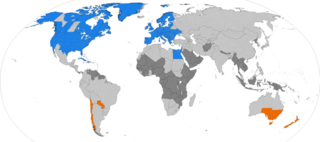
An hour is a unit of time historically reckoned as 1⁄24 of a day and defined contemporarily as exactly 3,600 seconds (SI). There are 60 minutes in an hour, and 24 hours in a day.

In everyday use and in kinematics, the speed of an object is the magnitude of the change of its position over time or the magnitude of the change of its position per unit of time; it is thus a scalar quantity. The average speed of an object in an interval of time is the distance travelled by the object divided by the duration of the interval; the instantaneous speed is the limit of the average speed as the duration of the time interval approaches zero. Speed is the magnitude of velocity, which indicates additionally the direction of motion.

A year is the time taken for astronomical objects to complete one orbit. For example, a year on Earth is the time taken for Earth to revolve around the Sun. Generally, a year is taken to mean a calendar year, but the word is also used for periods loosely associated with the calendar or astronomical year, such as the seasonal year, the fiscal year, the academic year, etc. The term can also be used in reference to any long period or cycle, such as the Great Year.

In probability theory, a probability density function (PDF), density function, or density of an absolutely continuous random variable, is a function whose value at any given sample in the sample space can be interpreted as providing a relative likelihood that the value of the random variable would be equal to that sample. Probability density is the probability per unit length, in other words, while the absolute likelihood for a continuous random variable to take on any particular value is 0, the value of the PDF at two different samples can be used to infer, in any particular draw of the random variable, how much more likely it is that the random variable would be close to one sample compared to the other sample.

Daylight saving time (DST), also referred to as daylight savings time, daylight time, or summer time, is the practice of advancing clocks to make better use of the longer daylight available during summer, so that darkness falls at a later clock time. The typical implementation of DST is to set clocks forward by one hour in spring or late winter, and to set clocks back by one hour to standard time in the autumn.

The glucose tolerance test is a medical test in which glucose is given and blood samples taken afterward to determine how quickly it is cleared from the blood. The test is usually used to test for diabetes, insulin resistance, impaired beta cell function, and sometimes reactive hypoglycemia and acromegaly, or rarer disorders of carbohydrate metabolism. In the most commonly performed version of the test, an oral glucose tolerance test (OGTT), a standard dose of glucose is ingested by mouth and blood levels are checked two hours later. Many variations of the GTT have been devised over the years for various purposes, with different standard doses of glucose, different routes of administration, different intervals and durations of sampling, and various substances measured in addition to blood glucose.

A sundial is a horological device that tells the time of day when direct sunlight shines by the apparent position of the Sun in the sky. In the narrowest sense of the word, it consists of a flat plate and a gnomon, which casts a shadow onto the dial. As the Sun appears to move through the sky, the shadow aligns with different hour-lines, which are marked on the dial to indicate the time of day. The style is the time-telling edge of the gnomon, though a single point or nodus may be used. The gnomon casts a broad shadow; the shadow of the style shows the time. The gnomon may be a rod, wire, or elaborately decorated metal casting. The style must be parallel to the axis of the Earth's rotation for the sundial to be accurate throughout the year. The style's angle from horizontal is equal to the sundial's geographical latitude.

Solar time is a calculation of the passage of time based on the position of the Sun in the sky. The fundamental unit of solar time is the day, based on the synodic rotation period. Traditionally, there are three types of time reckoning based on astronomical observations: apparent solar time and mean solar time, and sidereal time, which is based on the apparent motions of stars other than the Sun.

A kilowatt-hour is a non-SI unit of energy equal to 3.6 megajoules (MJ) in SI units which is the energy delivered by one kilowatt of power for one hour. Kilowatt-hours are a common billing unit for electrical energy supplied by electric utilities. Metric prefixes are used for multiples and submultiples of the basic unit, the watt-hour.

James Stephen Fossett was an American businessman and a record-setting aviator, sailor, and adventurer. He was the first person to fly solo nonstop around the world in a balloon and in a fixed-wing aircraft. He made his fortune in the financial services industry and held world records for five nonstop circumnavigations of the Earth: as a long-distance solo balloonist, as a sailor, and as a solo flight fixed-wing aircraft pilot.

The Adirondack is an intercity rail passenger train operated daily, partially along the Empire Corridor, by Amtrak between New York City and Montreal. Trains take approximately 11 hours to travel the 381 miles (613 km) route through the scenic Hudson Valley and along the eastern border of the Adirondack Mountains. Operation of the Adirondack is supported by the New York State Department of Transportation and Via Rail. Service was suspended in March 2020 due to the closure of the Canada–United States border in response to the COVID-19 pandemic, resumed in spring 2023, and suspended again at the end of June 2023 because of track conditions in Canada. Service again resumed in September. Amtrak reported that Adirondack served 26,892 passengers in fiscal year 2023, down from pre-COVID-19 pandemic ridership of 117,490 in FY2019.
Failure rate is the frequency with which an engineered system or component fails, expressed in failures per unit of time. It is usually denoted by the Greek letter λ (lambda) and is often used in reliability engineering.

The 24 Hours of Le Mans is an endurance-focused sports car race held annually near the town of Le Mans, France. It is widely considered to be one of the world's most prestigious races, and is one of the races—along with the Monaco Grand Prix and Indianapolis 500—that form the Triple Crown of Motorsport, and is also one of the races alongside the 24 Hours of Daytona and 12 Hours of Sebring that make up the informal Triple Crown of endurance racing. Run since 1923, it is the oldest active endurance racing event in the world.

Sedentary lifestyle is a lifestyle type, in which one is physically inactive and does little or no physical movement and/or exercise. A person living a sedentary lifestyle is often sitting or lying down while engaged in an activity like socializing, watching TV, playing video games, reading or using a mobile phone or computer for much of the day. A sedentary lifestyle contributes to poor health quality, diseases as well as many preventable causes of death.

KOB is a television station in Albuquerque, New Mexico, United States, affiliated with NBC. It is owned by Hubbard Broadcasting, whose sister cable channel Reelz is also based in Albuquerque. KOB's studios are located on Broadcast Plaza just west of downtown, and its transmitter is located on Sandia Crest, east of Albuquerque.
NATO designations are specified in Allied Administrative Publication AAP-6 NATO Glossary of Terms and Definitions, and marked (NATO) in this list. Entries specific to the U.S. and defined only in Joint Publication JP 1-02 are marked (US).

The Orlan space suit is a series of semi-rigid one-piece space suit models designed and built by NPP Zvezda. They have been used for spacewalks (EVAs) in the Russian space program, the successor to the Soviet space program, and by space programs of other countries, including NASA.

In the military, D-Day is the day on which a combat attack or operation is to be initiated. The best-known D-Day is during World War II, on June 6, 1944—the day of the Normandy landings—initiating the Western Allied effort to liberate western Europe from Nazi Germany. However, many other invasions and operations had a designated D-Day, both before and after that operation.
The watt is the unit of power or radiant flux in the International System of Units (SI), equal to 1 joule per second or 1 kg⋅m2⋅s−3. It is used to quantify the rate of energy transfer. The watt is named in honor of James Watt (1736–1819), an 18th-century Scottish inventor, mechanical engineer, and chemist who improved the Newcomen engine with his own steam engine in 1776. Watt's invention was fundamental for the Industrial Revolution.

The kilometre per hour is a unit of speed, expressing the number of kilometres travelled in one hour.
















